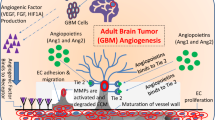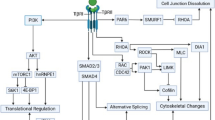Abstract
Angiogenesis is induced by soluble factors such as vascular endothelial growth factor (VEGF) released from tumor cells in hypoxia. It enhances solid tumor growth and provides an ability to establish metastasis at peripheral sites by tumor cell migration. Thymosin beta-4 (TB4) is an actin-sequestering protein to control cytoskeletal reorganization. Here, we investigated whether angiogenesis and tumor metastasis are dependent on hypoxia conditioning-induced TB4 expression in B16F10 melanoma cells. TB4 expression in B16F10 cells was increased by hypoxia conditioning in a time-dependent manner. In addition, we found an increase of angiogenesis and HIF-1α expression in TB4-transgenic (Tg) mice as compared to wildtype mice. When wound healing assay was used to assess in vitro tumor cell migration, hypoxia conditioning for 1 h enhanced B16F10 cell migration. When TB4 expression in B16F10 cells was inhibited by the infection with small hairpin (sh) RNA of TB4 cloned in lentiviral vector, tumor cell migration was retarded. In addition, hypoxia conditioning-induced tumor cell migration was reduced by the infection of lentiviral shRNA of TB4. HIF-1α stabilization and the expression of VEGF isoform 165 and 121 in hypoxia were also reduced by the infection of lentiviral shRNA of TB4 in B16F10 cells. We also found an increase of tumor growth and lung metastasis count in TB4-Tg mice as compared to wildtype mice. Collectively, hypoxia conditioning induced tumor cell migration by TB4 expression-dependent HIF-1α stabilization. It suggests that TB4 could be a hypoxia responsive regulator to control tumor cell migration in angiogenesis and tumor metastasis.





Similar content being viewed by others
Abbreviations
- TB4:
-
Thymosin-beta-4
- HIF-1α:
-
Hypoxia inducible transcription factor 1 alpha
- VEGF:
-
Vascular endothelial growth factor
- Tg:
-
Transgenic
References
Huff T, Muller CS, Otto AM et al (2001) Beta-thymosins, small acidic peptides with multiple functions. Int J Biochem Cell Biol 33:205–220
Domanski M, Hertzog M, Coutant J et al (2004) Coupling of folding and binding of thymosin beta4 upon interaction with monomeric actin monitored by nuclear magnetic resonance. J Biol Chem 279:23637–23645
Hertzog M, van Heijenoort C, Didry D et al (2004) The beta-thymosin/WH2 domain; structural basis for the switch from inhibition to promotion of actin assembly. Cell 117:611–623
Cha HJ, Jeong MJ, Kleinman HK (2003) Role of thymosin beta4 in tumor metastasis and angiogenesis. J Natl Cancer Inst 95:1674–1680
Goldstein AL (2003) Thymosin beta4: a new molecular target for antitumor strategies. J Natl Cancer Inst 95:1646–1647
Sosne G, Siddiqi A, Kurpakus-Wheater M (2004) Thymosin-beta4 inhibits corneal epithelial cell apoptosis after ethanol exposure in vitro. Invest Ophthalmol Vis Sci 45:1095–1100
Oh SY, Song JH, Gil JE et al (2006) ERK activation by thymosin-beta-4 (TB4) overexpression induces paclitaxel-resistance. Exp Cell Res 312:1651–1657
Oh JM, Ryoo IJ, Yang Y et al (2008) Hypoxia-inducible transcription factor (HIF)-1 alpha stabilization by actin-sequestering protein, thymosin beta-4 (TB4) in Hela cervical tumor cells. Cancer Lett 264:29–35
Wang GL, Jiang BH, Rue EA et al (1995) Hypoxia-inducible factor 1 is a basic-helix-loop-helix-PAS heterodimer regulated by cellular O2 tension. Proc Natl Acad Sci USA 92:5510–5514
Folkman J (1990) What is the evidence that tumors are angiogenesis dependent? J Natl Cancer Inst 82:4–6
Dong JEH, Shin CY (2008) Vasorelaxing effect of hypoxia via Rho-kinase inhibition on the agonist-specific vasoconstriction. Biomol Ther 16:249–254
Ke Q, Costa M (2006) Hypoxia-inducible factor-1 (HIF-1). Mol Pharmacol 70:1469–1480
Huang LE, Gu J, Schau M et al (1998) Regulation of hypoxia-inducible factor 1alpha is mediated by an O2-dependent degradation domain via the ubiquitin-proteasome pathway. Proc Natl Acad Sci USA 95:7987–7992
Zhang T, Li X, Yu W et al (2009) Overexpression of thymosin beta-10 inhibits VEGF mRNA expression, autocrine VEGF protein production, and tube formation in hypoxia-induced monkey choroid-retinal endothelial cells. Ophthalmic Res 41:36–43
Ferrara N, Houck K, Jakeman L et al (1992) Molecular and biological properties of the vascular endothelial growth factor family of proteins. Endocr Rev 13:18–32
Houck KA, Ferrara N, Winer J et al (1991) The vascular endothelial growth factor family: identification of a fourth molecular species and characterization of alternative splicing of RNA. Mol Endocrinol 5:1806–1814
White FC, Carroll SM, Kamps MP (1995) VEGF mRNA is reversibly stabilized by hypoxia and persistently stabilized in VEGF-overexpressing human tumor cell lines. Growth Factors 12:289–301
Gunningham SP, Currie MJ, Han C et al (2001) Vascular endothelial growth factor-B and vascular endothelial growth factor-C expression in renal cell carcinomas: regulation by the von Hippel-Lindau gene and hypoxia. Cancer Res 61:3206–3211
Singer SJ, Kupfer A (1986) The directed migration of eukaryotic cells. Annu Rev Cell Biol 2:337–365
Park SY, Jeong KJ, Lee J et al (2007) Hypoxia enhances LPA-induced HIF-1alpha and VEGF expression: their inhibition by resveratrol. Cancer Lett 258:63–69
Jiang M, Wang B, Wang C et al (2006) Inhibition of hypoxia-inducible factor-1alpha and endothelial progenitor cell differentiation by adenoviral transfer of small interfering RNA in vitro. J Vasc Res 43:511–521
Lin S, Sun L, Hu J et al (2009) Chemokine C-X-C motif receptor 6 contributes to cell migration during hypoxia. Cancer Lett 279:108–117
Semenza GL (2000) HIF-1: using two hands to flip the angiogenic switch. Cancer Metastasis Rev 19:59–65
Yu DY, Moon HB, Son JK et al (1999) Incidence of hepatocellular carcinoma in transgenic mice expressing the hepatitis B virus X-protein. J Hepatol 31:123–132
Follenzi A, Ailles LE, Bakovic S et al (2000) Gene transfer by lentiviral vectors is limited by nuclear translocation and rescued by HIV-1 pol sequences. Nat Genet 25:217–222
Dull T, Zufferey R, Kelly M (1998) A third-generation lentivirus vector with a conditional packaging system. J Virol 72:8463–8471
Drabkin DS, Austin JH et al (1932) Spectrophotometric constants for common hemoglobin derivatives in human, dog, and rabbit blood. J Biol Chem 98:719–733
Borisy GG, Svitkina TM (2000) Actin machinery: pushing the envelope. Curr Opin Cell Biol 12:104–112
Pantaloni D, Le Clainche C, Carlier MF (2001) Mechanism of actin-based motility. Science 292:1502–1506
Turcotte S, Desrosiers RR, Beliveau R (2003) HIF-1alpha mRNA and protein upregulation involves Rho GTPase expression during hypoxia in renal cell carcinoma. J Cell Sci 116:2247–2260
Safer D, Nachmias VT (1994) Beta thymosins as actin binding peptides. Bioessays 16:473–479
Michiels C, Minet E, Michel G et al (2001) HIF-1 and AP-1 cooperate to increase gene expression in hypoxia: role of MAP kinases. IUBMB Life 52:49–53
Mottet D, Michel G, Renard P et al (2002) ERK and calcium in activation of HIF-1. Ann N Y Acad Sci 973:448–453
Mottet D, Michel G, Renard P et al (2003) Role of ERK and calcium in the hypoxia-induced activation of HIF-1. J Cell Physiol 194:30–44
Minet E, Arnould T, Michel G et al (2000) ERK activation upon hypoxia: involvement in HIF-1 activation. FEBS Lett 468:53–58
Huang HC, Hu CH, Tang MC et al (2007) Thymosin beta4 triggers an epithelial-mesenchymal transition in colorectal carcinoma by upregulating integrin-linked kinase. Oncogene 26:2781–2790
Acknowledgments
This work was supported by grants (#0920270) from National Cancer Control Program, (#A080076) of the Korea Healthcare technology R&D Project, Ministry of Health and Welfare and National Nuclear R&D Program (#2010-0018545) through National Research Foundation of Korea (NRF) funded by the Ministry of Education, Science and Technology (MEST), Korea.
Author information
Authors and Affiliations
Corresponding author
Rights and permissions
About this article
Cite this article
Moon, EY., Im, YS., Ryu, YK. et al. Actin-sequestering protein, thymosin beta-4, is a novel hypoxia responsive regulator. Clin Exp Metastasis 27, 601–609 (2010). https://doi.org/10.1007/s10585-010-9350-z
Received:
Accepted:
Published:
Issue Date:
DOI: https://doi.org/10.1007/s10585-010-9350-z




